|
|
Updated as per
AN ANNOTATED CHECKLIST OF THE SPHINGIDAE OF BOLIVIA, October 2007
Updated as per http://www.pybio.org/MACROGLOSSINAE.htm (Paraguay), October 2007
Updated as per More, Kitching and Cocucci's Hawkmoths of Argentina 2005, October, 2007
Updated as per personal communication with Ezequiel Osvaldo Núñez Bustos (Argentina), Ocotber 2007
Updated as per personal communication with Johan van't Bosch (Mato
Grosso, Brazil, August 23), March 2008
Updated as per personal communication with Vladimir Izersky (Rio Venado, Junin, Peru, 1050m, February 18, 2008),
December 2008
Updated as per personal communication with Jose Monzon (Guatemala); May 2009
Updated as per Sphingidae (Lepidoptera) de Venezuela, Compilado por: María Esperanza Chacín; December 2009
Updated as per French Guiana Systematics; April 12, 2011
Updated as per personal communication with Ben Trott (Playa del Carmen, Quintana Roo, Mexico); February 26, 2012
Updated as per personal communication with Hubert Mayer (La Union del Toachi, Pichincha, Ecuador); June 2, 2014
Updated as per personal communication with Sergio D. Ríos Díaz in CATÁLOGO DE LOS SPHINGIDAE (INSECTA: LEPIDOPTERA) DEPOSITADOS EN
EL MUSEO NACIONAL DE HISTORIA NATURAL DEL PARAGUAY; sent to me in July 2014 by Sergio D. Ríos Díaz.
Updated as per personal communication with Ezequiel Bustos (Shilap revta. lepid. 43 (172) diciembre, 2015, 615-631 eISSN 2340-4078 ISSN 0300-5267), January 4, 2016
Updated as per personal communication with Paula Larizzatti (Pinhalzinho, Sao Paulo, Brazil, April 22, 2016, 910m); April 22, 2016
Updated as per personal communication with Bruno Moraes (Nova Lima, Minas Gerais, Brazil, March 25, 2017, 18 days pupa to moth); March 25, 2017
Updated as per personal communication with Lucius Rabello Vasconcellos (Three Rivers, Rio de Janeiro, Brazil, April 13, 2019); April 15, 2019
Updated as per personal communication with Paulo Renato Huppes (Caraa, Rio Grande do Sul, Brazil, June 2, 2019); June 3, 2019
|
Enyo gorgon
EN-yohMGOR-gon
(Cramer, 1777) Sphinx
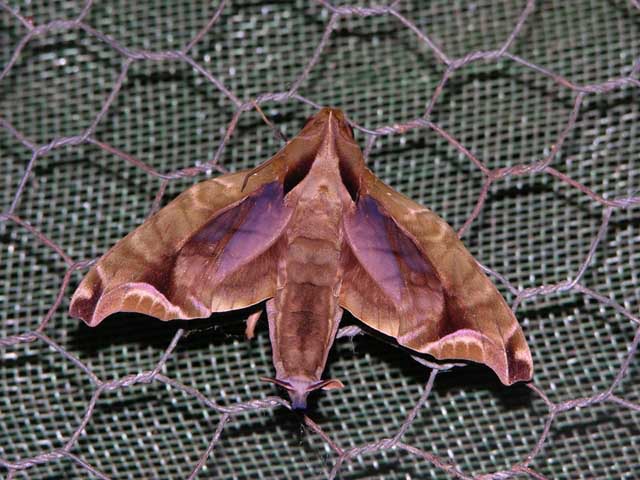
Enyo gorgon, Cristalino Jungle Lodge, Mato Grosso, Brazil,
August 23, 2007, 71m, courtesy/copyright of Johan van't Bosch.
This site has been created by Bill Oehlke. Comments, suggestions and/or additional information are welcomed by Bill.
TAXONOMY:
Family: Sphingidae, Latreille, 1802
Subfamily: Macroglossinae, Harris, 1839
Tribe: Dilophonotini, Burmeister, 1878
Genus: Enyo Hubner, [1819] ...........
Species: gorgon gorgon (Cramer, 1777)
|
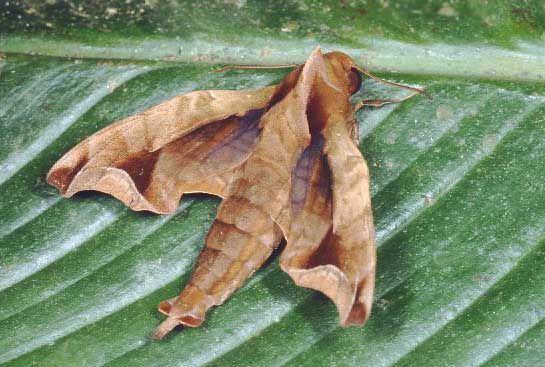
Enyo gorgon gorgon courtesy of Paolo Mazzei.
DISTRIBUTION:
Enyo gorgon gorgon
(wingspan: approx. 66-72 mm)
flies in
Mexico: Quintana Roo (BT) and elsewhere; and
Belize: Corozol, Cayo, probably Orange Walk through
Guatemala;
Honduras;
El Salvador;
Nicaragua;
Costa Rica;
Panama;
Venezuela: Aragua, Barinas, Bolivar,
Distrito Federal, Miranda, Portuguesa, Tachira, Trujillo, Yaracuy;
Guyana;
Suriname;
French Guiana: Kaw;
Brazil: Mato Grosso; Rio de Janeiro: Three Rivers (LRV); Sao Paulo (PL); Minas Gerais: Nova Lima (BM); Rio Grande do Sul: Caraa (PRH)
Colombia;
Ecuador: Pichincha (HM);
Peru: Junin;
Paraguay: Presidente Hayes, Concepcion,
San Pedro, Canindeyu, Alto Parana, Cordillera, Caaguazu, Paraguari,
Guaira, Caazapa, (probably Central and Itapua (WO));
Argentina: Misiones and
Bolivia: "Santa Cruz: Andrés Ibáñez; La Paz: Larecaja, San Agustín, Mapiri,
3500'." Jean Haxaire.
Surinam is the specimen type locality.
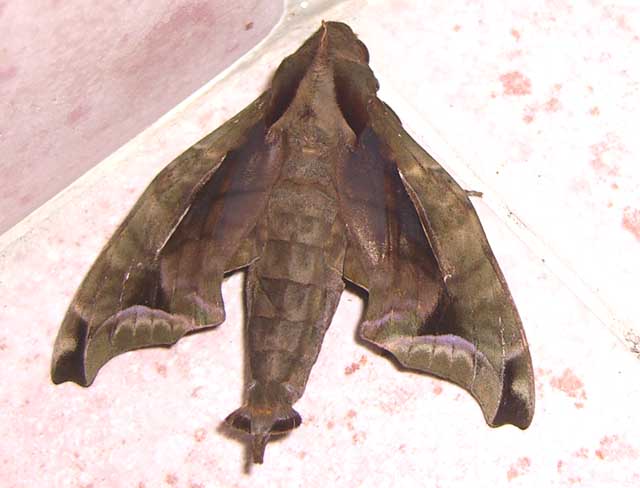
Enyo gorgon, April, 2007, southern Yucatan peninsula, near Tulum, Mexico,
courtesy of Nina C. Wilde.
FLIGHT TIMES:
Enyo gorgon gorgon probably has two to three broods annually, with adults taken in Costa Rica from
May to June, August to September and from December to January.
In Bolivia, specimens have been recorded in October-November. Johan van't Bosch reports an August flight in Mato Grosso, Brazil.
Lucius Rabello Vasconcellos reports and April flight in Three Rivers, Rio de Janeiro, Brazil. Paulo Renato Huppes reports an early June flight in
Caraa, Rio Grande do Sul, Brazil.
Vladimir Izersky reports them on the wing in February in Peru.
Paula Larizzatti reports an April flight of Enyo gorgon in Pinhalzinho, Sao Paulo, Brazil.
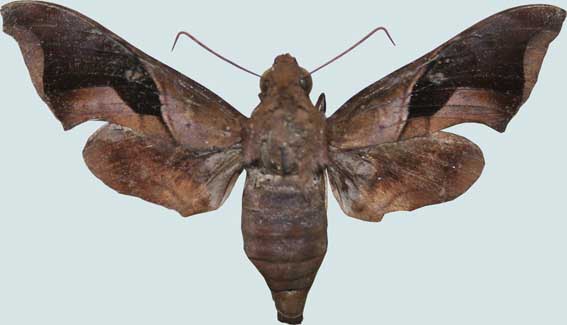
Enyo gorgon female, Rio Venado, Junin, Peru,
February 18, 2008, 1050m, courtesy of Vladimir Izersky.
Early evening, just prior to 7:00 pm seems to be a popular flight time response to lights in Bolivia with both males and females coming to lights.
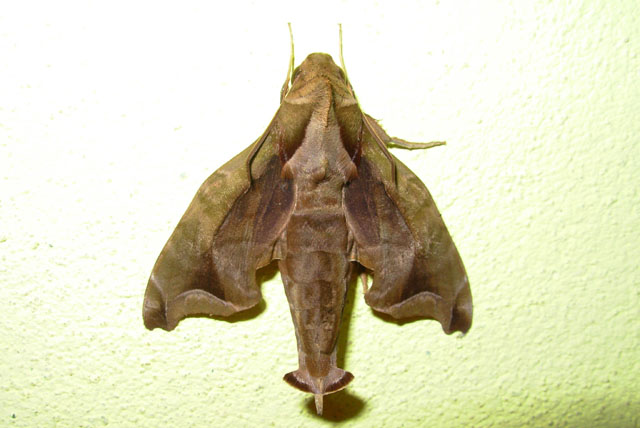
Enyo gorgon, Yacutinga Private Reserve, Misiones, Argentina,
September 2007, courtesy/copyright
Ezequiel Osvaldo Núñez Bustos.
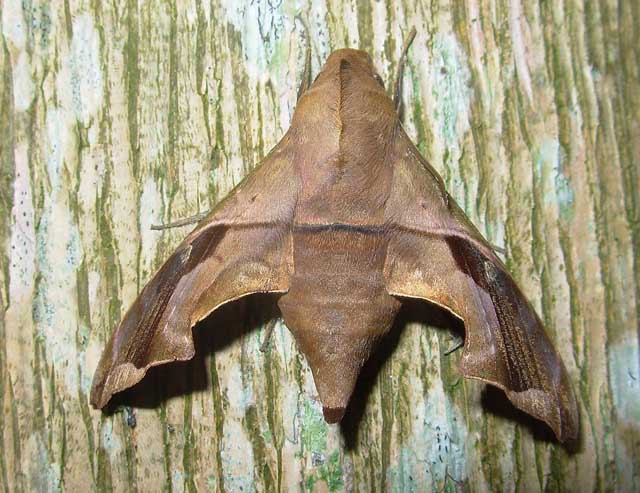
Enyo gorgon female, Cerro Santa Ana, Misiones, Argentina,
August 12, 2010, courtesy/copyrightEzequiel Osvaldo Núñez Bustos.
ECLOSION:
Adults eclose from pupae formed in subterranean chambers.
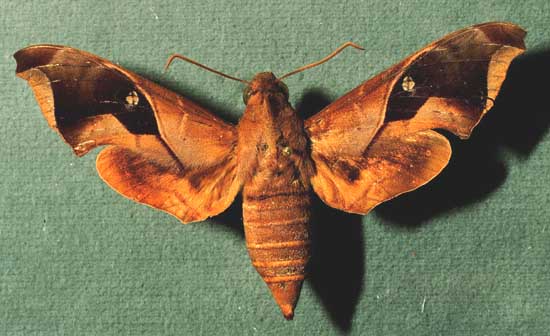
Enyo gorgon gorgon female courtesy of Dan Janzen.
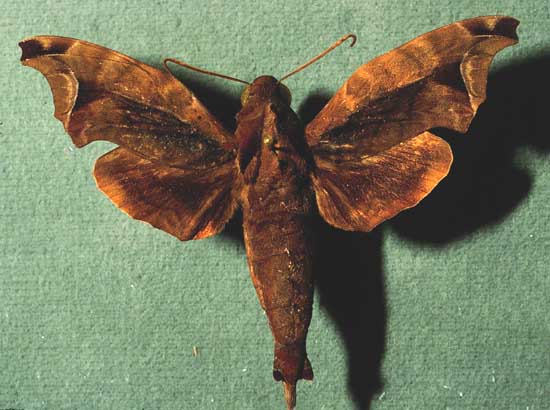
Enyo gorgon gorgon male courtesy of Dan Janzen.
SCENTING AND MATING:
Females call in the males with a pheromone released from a gland at the tip of the
abdomen. Both males and females nectar at flowers. Females, active from 12:30 - 2:00 pm, are seldom taken at lights while males, active
from 1:00 - 3:00 am, are more common.
EGGS, LARVAE, PUPAE:
Larvae feed on Vitus tiliifolia
and other members of the Vitaceae family. The "horn" is very long in early instars and head is relatively large. |
 |
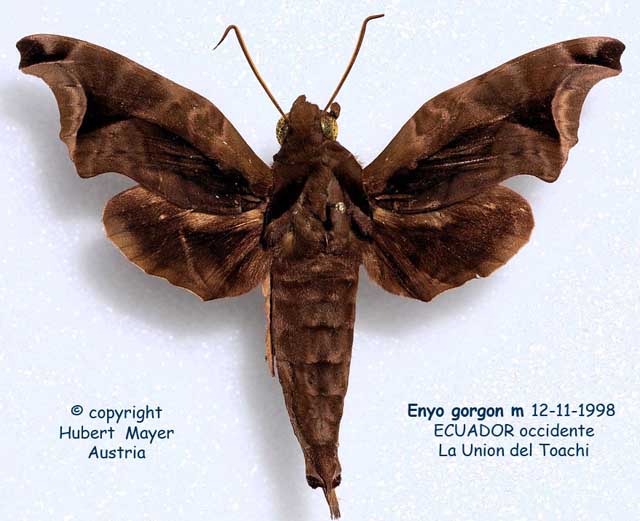
Enyo gorgon male, La Union del Toachi, Pichincha, Ecuador,
November 12, 1998, courtesy of Hubert Mayer.
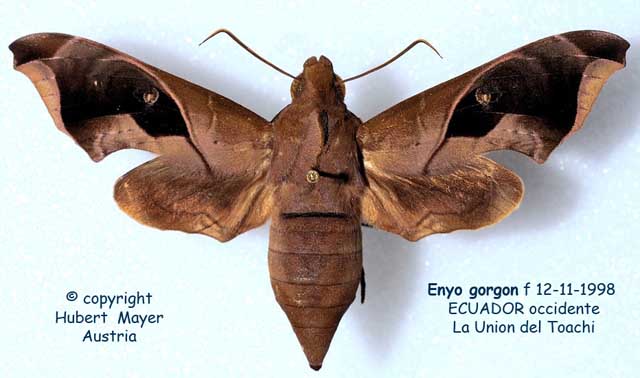
Enyo gorgon female, La Union del Toachi, Pichincha, Ecuador,
November 12, 1998, courtesy of Hubert Mayer.
Ben Trott writes, "Enyo gorgon (x1). Found by mistake while cutting food for the Eumorpha species (they eat the same ivy/vine).
I can't tell the difference between E. gorgon & E. cavifer larvae. At the moment I think I have 2 cavifer pupae & 1 gorgon larva, I'll see when they
hatch." Ben sends the images below from Quintana Roo, Mexico.
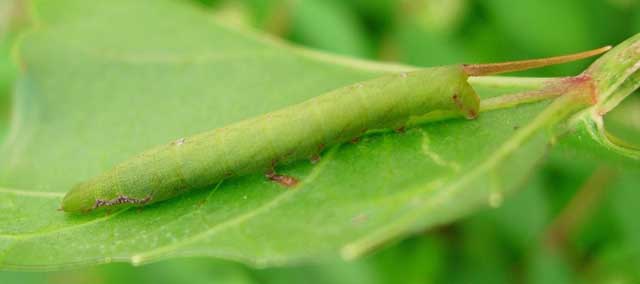
Enyo gorgon third instar, Playa del Carmen, Quintana Roo, Mexico,
courtesy of Ben Trott
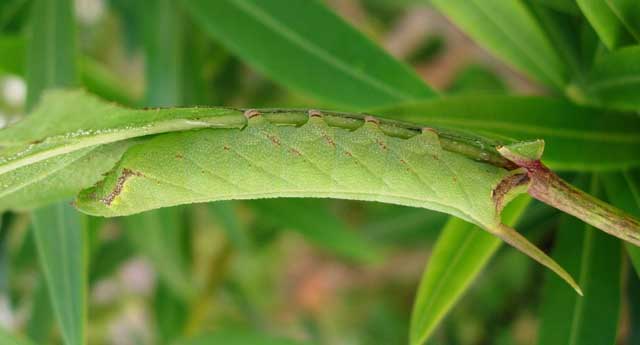
Enyo gorgon fourth instar, Playa del Carmen, Quintana Roo, Mexico,
courtesy of Ben Trott
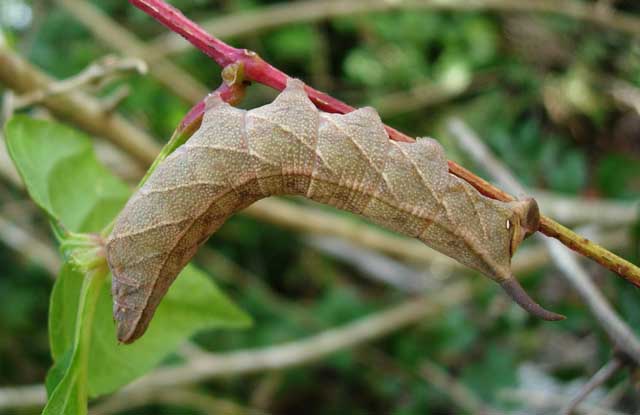
Enyo gorgon fifth instar, Playa del Carmen, Quintana Roo, Mexico,
courtesy of Ben Trott
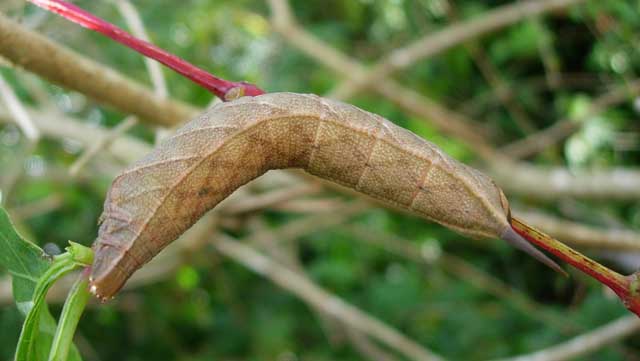
Enyo gorgon fifth instar, Playa del Carmen, Quintana Roo, Mexico,
courtesy of Ben Trott
Larvae also feed on Tetracera volubilis of the Dilleniaceae family. The "horn" is quite diminished in the final
instar and now the head is small compared to body girth.
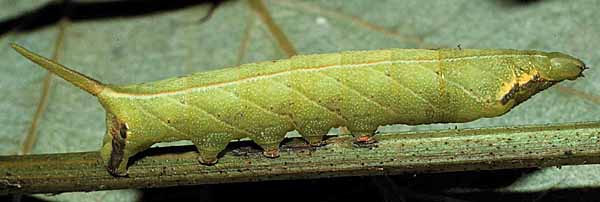
Eclosion from pupa is about four weeks after pupation, although Bruno Moraes has reported eclosion in as few as 18 days.
The pupa is dark and smooth with a long, sharp cremaster. | 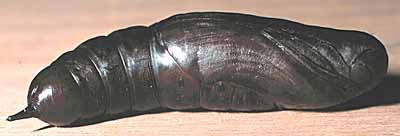 |
Use your browser "Back" button to return to the previous page.
Return to Sphingidae Index
Return to Dilophonotini Tribe
Visit Enyo Gorgon additional images.
Use your browser "Back" button to return to the previous page.
This page is brought to you by Bill Oehlke and the WLSS.
Pages are on space rented from Bizland. If you would like to become a "Patron of the Sphingidae Site", contact Bill.
Please send sightings/images to Bill. I will do my best to respond to requests for identification help.
Enjoy one of nature's wonderments: Live Saturniidae (Giant Silkmoth) cocoons.
 | 
Show appreciation for this site by clicking on flashing butterfly to the left.
The link will take you to a page with links to many insect sites. |


















